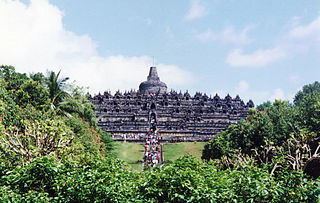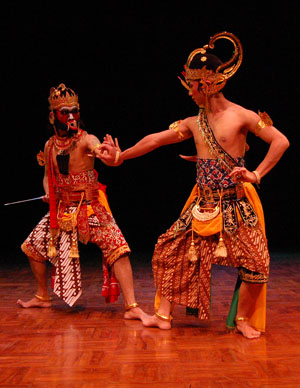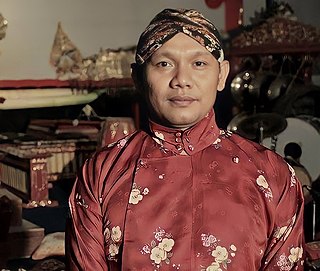
Petruk is a character in traditional Javanese puppetry, or wayang . He is one of the Punokawan , four comedic figures common in the medium.

Petruk is a character in traditional Javanese puppetry, or wayang . He is one of the Punokawan , four comedic figures common in the medium.
Petruk is one of the four Punokawan , together with Semar (the leader/father figure), Bagong, and Gareng; Petruk acts as the middle child. They are portrayed living together as a harmonious family. [1] The Punokawan, often referred to as clowns in English, provide comic relief in the stories they are in, but also serve to speak to the audience and convey ideas of the dhalang (puppeteer), including social criticism. [2]
Petruk is depicted as having lengthy limbs and a long nose; his nose is generally considered his most distinctive feature. [3] In wayang performances the dhalang generally provides a "warrior's voice" for Petruk, as opposed to the nasal voice used for his brothers. [1] He is married to Dewi Ambarawati, [4] whom he won the right to marry after defeating four other suitors in a vicious battle. Together they have a son, Lengkungkusuma. [4]
Petruk and the punokawan, who are not present in the original Indian versions of the Mahabharata, are thought to have been an original Javanese creation. [5] The Batara Ismaya Krama details Petruk's origin as follows. He was originally a noble raksasa known as Bambang Pecruk Panyukilan. He was humorous yet quick to fight, enjoyed joking but a furious warrior. One day, he departed his home to test his strength. Meeting Bambang Sukakadi, he challenged the latter to fight. The two fought for an extended period of time, until ultimately their entire bodies were covered in bruises and both had lost their once-handsome appearances. The fight was only stopped after Bagong and Smarasanta came together with Semar; Semar ordered the fighting men to stop and join him as his students. Afterwards Bambang Pecruk Panyukilan became Petruk, whereas Bambang Sukakadi became Gareng. [6]
During the Dutch colonial period, a wayang story entitled Petruk Dadi Ratu (Petruk Becomes King) arose as a veiled criticism of the Dutch colonial powers. In this story, Petruk (in the guise of Prabu Welgeduwelbeh) overthrows his brother Gareng to become king of Trancanggribig; he is ultimately overthrown by Bagong, until the kingdom is surrendered to the Pandawa. [7] Other contemporary stories exist as well. In Petruk Ilang Petele (Petruk Loses His Axe), Petruk loses his axe, whereas in Ambangun Candi Saptaharga a woman named Dewi Mustakaweni steals a sacred relic known as Kalimasada, after which Petruk steals it back. [7]
Petruk and the Punokawan can also be found in modern Indonesian literature. In Nano Riantiarno's Semar Gugat (1995), for instance, Petruk appears as a son of Semar who abandons him after the latter loses his powers. [8] Allusions to the character can be found in cartoons. [2]

Wayang, also known as wajang, is a traditional form of puppet theatre play originating from the Indonesian island of Java. Wayang refers to the entire dramatic show. Sometimes the leather puppet itself is referred to as wayang. Performances of wayang puppet theatre are accompanied by a gamelan orchestra in Java, and by gender wayang in Bali. The dramatic stories depict mythologies, such as episodes from the Hindu epics the Ramayana and the Mahabharata, as well as local adaptations of cultural legends. Traditionally, a wayang is played out in a ritualized midnight-to-dawn show by a dalang, an artist and spiritual leader; people watch the show from both sides of the screen.

Kakawin Ramayana is an Old Javanese poem rendering of the Sanskrit Ramayana in kakawin meter.

Topeng is a dramatic form of Indonesian dance in which one or more mask-wearing ornately costumed performers interpret traditional narratives concerning fabled kings, heroes, and myths, accompanied by gamelan or other traditional music instruments. Topeng dance is a typical Indonesian dance that can be found in various regions of Indonesia. Topeng dance has the main characteristic that the dancers use masks to cover their faces. The dance will usually be performed by one dancer or a group of dancers.

Dalang or dhalang is a native Javan term commonly used in Javan–Bali cultures, referring to the individuals who responsible as the plotter or puppeteer of various Wayang performance. Originating from the Javanese cultural tradition, the Dalang practice first emerged and developed on the Indonesian island of Java, particularly in the courts of central–southern regions which considered as the origin place of these traditional cultural practice. Due to the massive spread of Central Javanese influence, the practice of Dalang puppeteering was also introduced to its vicinity eastern region, which now comprises the states of East Java and Bali.

Wayang wong, also known as wayang orang, is a type of classical Javanese and Balinese dance theatrical performance with themes taken from episodes of the Ramayāna or Mahabharāta. Performances are stylised, reflecting Javanese court culture:
Wayang wong dance drama in the central Javanese Kraton of Yogyakarta represents the epitome of Javanese aesthetic unity. It is total theatre involving dance, drama, music, visual arts, language, and literature. A highly cultured sense of formality permeates every aspect of its presentation.

Folklore of Indonesia is known in Indonesian as dongeng, cerita rakyat or folklor, refer to any folklore found in Indonesia. Its origins are probably an oral culture, with a range of stories of heroes associated with wayang and other forms of theatre, transmitted outside of a written culture. Folklore in Indonesia are closely connected with mythology.

Sulukan normally refers to mood setting songs by a puppeteer (dhalang) in Javanese wayang ("puppet") performances in Indonesia. The term can also refer to the pathetan pieces played before and after gamelan pieces in a non-wayang context, and to mystical poetry relating to the doctrinal meaning of the term sulook.

In Javanese wayang, the panakawan or panakavan (phanakavhan) are the clown servants of the hero. There are four of them – Semar, Petruk, Gareng and Bagong. Semar is the personification of a deity, sometimes said to be the dhanyang or guardian spirit of the island of Java. In Javanese mythology, deities can only manifest themselves as ugly or otherwise unprepossessing humans, and so Semar is always portrayed as short and fat with a pug nose and a dangling hernia.

Semar is a character in Javanese mythology who frequently appears in wayang shadow plays. He is one of the punokawan (clowns) but is divine and very wise. He is the dhanyang of Java, and is regarded by some as the most sacred figure of the wayang set. He is said to be the god Sang Hyang Ismaya in human form.

The Panji tales are a cycle of Javanese stories, centred around the legendary prince of the same name from East Java, Indonesia. Along with the Ramayana and Mahabharata, the tales are the basis of various poems, sculpture and painting, dance-drama performances and genres of wayang, especially the one known in East and Central Java as wayang gedhog. Panji tales have been the inspiration of Indonesian traditional dances, most notably the topeng (mask) dances of Cirebon, Central Java and Malang, as well as gambuh dance-drama in Bali. Especially in the environs of Kediri, part of the probable homeland of the tales of Panji, local stories grew and were connected with the obscure legendary figure of Totok Kerot. Panji tales have spread from East Java (Indonesia) to be a fertile source for literature and drama throughout Indochina Peninsula and Malay World as well.

The Royal Palace of Yogyakarta is a palace complex in the city of Yogyakarta, Yogyakarta Special Region, Indonesia. It is the seat of the reigning Sultan of Yogyakarta and his family. The complex is a center of Javanese culture and contains a museum displaying royal artifacts. It is guarded by the Yogyakarta Kraton Guards.

Dewi Sri or Shridevi is the Javanese, Sundanese, and Balinese Hindu Goddess of rice and fertility, still widely worshiped on the islands of Java, Bali and Lombok, Indonesia. She is often associated or equated with the Hindu goddess Lakshmi, the shakti (consort) of Vishnu.

Cepot or Astrajingga is one of the wayang golek characters in Sundanese puppetry. Cepot is a punokawan alongside Dawala and Garéng, which do not exist in the original Mahabharata or Ramayana. Cepot is one of Semar's sons. Cepot is a rural character from the fictional village Tumaritis, where he lived with his father Semar and two of his brothers, Petruk and Dawala. Cepot is humorous and easy going, everything Cepot says tends to be funny, and Cepot's act has many slapstick jokes, mostly done together with its antagonist wayang golek character. Cepot in wayang golek puppetry also has other, good looking faces: Astrajingga, described with its straight, humble, good looking and white face. Cepot is the favourite character of Sundanese Indonesian wayang golek maestro Asep Sunandar Sunarya.
Norbertus Riantiarno was an Indonesian actor, director, and playwright. While in high school, he studied under Teguh Karya and acted in several movies and plays, until he eventually established his own theatre troupe, Teater Koma, in 1977. His works, with their highly political messages, were often censored by Suharto's New Order government. In 1998 he won the SEA Write Award for his play Semar Gugat.

Semar Gugat is a stage play written by Nano Riantiarno for his troupe Teater Koma. It follows the traditional wayang character Semar as he attempts— and fails— to take revenge against Arjuna and Srikandi for humiliating him by cutting off a lock of his hair while they are under the influence of the demon queen Durga. Completed in mid-1995, the play consists of 559 lines of dialogue spread through 30 scenes. Semar Gugat has been read as a critique of the New Order government under president Suharto. It was first performed on 25 November 1995 after the government withheld permission for several months. After Teater Koma gave an initial two-week run, it was adapted by various amateur groups. In 1998 Riantiarno won a S.E.A. Write Award for the work.

Javanisation or Javanization is the process in which Javanese culture dominates, assimilates, or influences other cultures in general. The term "Javanise" means "to make or to become Javanese in form, idiom, style, or character". This domination could take place in various aspects; such as cultural, language, politics and social.
Prabakusuma in the Javanese wayang is also called by the name Bambang Priyambada. He is the son of Arjuna from his marriage with Princess Dewi Supraba who became his wife when he was the king of kahyangan. Prabukusuma is as handsome and strong as his father. His accuracy in shooting an arrow is quite unbeatable. He was raised by his grandfather, Sage Sidikwaspada from Glagahwangi Monastery. Prabukusuma helped Amarta Kingdom when Princess Mustakaweni stole Jamus Kalimasada by disguising to be Ghatotkacha
Bagong Kussudiardja was an Indonesian artist, contemporary dance choreographer and painter. Bagong’s career kicked off after Indonesia’s independence in 1945. As a dance choreographer, Bagong has choreographed more than 200 dances. Bagong perfected his skills by studying Japanese and Indian dances. In 1957 and 1958, Bagong trained under the well-known dance choreographer Martha Graham, known for her boundary-breaking techniques. Bagong then combined the modern moves with traditional Indonesian dances. After his training, he founded Pusat Latihan Tari Bagong Kussudiardja in 1958, followed by Padepokan Seni Bagong Kussudiardja in 1978.

Bambangan Cakil is a classical dance-drama of Javanese people in—particularly—Central Java, Indonesia. This dance-drama demonstrates wayang performance due to the movement is adopted from one of the scenes in wayang kulit performance, that is the Perang Kembang scene. The Perang Kembang told about war between kesatria and raksasa. The kesatria has soft and gentle characters, while the raksasa is described as a character who is rough and violent.

Seno Nugroho was an Indonesian artist and puppeteer. His name is widely known as the puppeteer through the wayang kulit performance that combines the Surakarta gagrag and the Yogyakarta gagrag. Another peculiarity that has made him famous is when he presents panakawan with jokes that are spontaneous, contextual, actual, and funny. Apart from performing in Indonesia, Seno Nugroho has also been invited to perform in the Netherlands and Belgium.